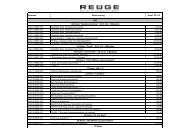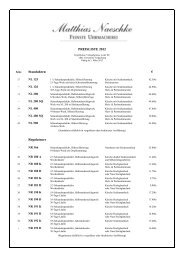TRADITION · PRECISION · PERFECTION - Erwin Sattler
TRADITION · PRECISION · PERFECTION - Erwin Sattler
TRADITION · PRECISION · PERFECTION - Erwin Sattler
Create successful ePaper yourself
Turn your PDF publications into a flip-book with our unique Google optimized e-Paper software.
Secunda Accurata 1958<br />
Air pressure compensation.<br />
In order to avoid a change in the period of oscillation when<br />
the air pressure changes, the pendulum is outfitted with an<br />
air pressure compensation device. If air pressure increases,<br />
the period of oscillation is lengthened. With five aneroid<br />
capsules and a precisely calculated weight that moves up or<br />
down corresponding to the changes in air pressure, these<br />
influences and thus a change in the period of oscillation are<br />
compensated.<br />
Temperature compensation.<br />
The rate precision of a pendulum clock<br />
does not exclusively depend upon the<br />
mechanical properties of the mechanism,<br />
but also on external physical influences.<br />
The pendulum’s period of oscillation<br />
is primarily determined by its length.<br />
Variations in temperature, however,<br />
result in a corresponding change in the<br />
materials used to create the pendulum.<br />
The pendulum rod of the Secunda<br />
Accurata 1958 is made of an ironnickel<br />
alloy called Superinvar, a material<br />
that can boast minimal linear expansion<br />
upon temperature change. In order to<br />
compensate for residual expansion as<br />
well, the pendulum is equipped with<br />
a temperature compensation device.<br />
Rate deviations of less than one second<br />
per month can be achieved with this<br />
clock.<br />
Titanium lever for energy transmission<br />
The function of the free Strasser escapement.<br />
The escapement of a clock, comprising the pallet assembly<br />
and the escape wheel, is the connecting link between the<br />
gear train and the oscillation system. The pendulum receives<br />
energy from the escapement, some of which gets lost due to<br />
friction in the suspension and air resistance. Until the free<br />
Strasser escapement was invented, the so-called Graham<br />
escapement served as the connecting link between the<br />
pendulum and the gear train. In this escapement, the pallets<br />
and the pendulum form a rather rigid connection via the pallet<br />
fork, the disadvantage being that even the slightest variations<br />
in the driving force are transmitted from the gear train to<br />
the pendulum.<br />
Impulse<br />
pallet<br />
Locking<br />
pallet<br />
Escape wheel<br />
Pendulum drive springs<br />
These energy variations result in a change of the pendulum’s<br />
amplitude of oscillation and thus slightly influence the period<br />
of oscillation. The invention of the free Strasser escapement<br />
made it possible to improve the already excellent rate<br />
accuracy of precision clocks, primarily achieved by decoupling<br />
the movement to a large extent from the oscillating system.<br />
The pendulum only remains linked to the pallets and movement<br />
by the mainspring. Thus, the pendulum is decoupled and<br />
swings nearly freely. The energy necessary to maintain<br />
oscillation is supplied to the pendulum at its fulcrum point by<br />
two thin steel springs pre-tensioned by the interplay between<br />
the escape wheel and the pallets around a precisely defined<br />
angle. Thus, the pendulum is supplied with exactly the same<br />
energy at every half-oscillation – in other words, once every<br />
second. This is why these escapements, like the one found<br />
in our precision pendulum clock Secunda Accurata 1958,<br />
are called constant force escapements.<br />
30 31






